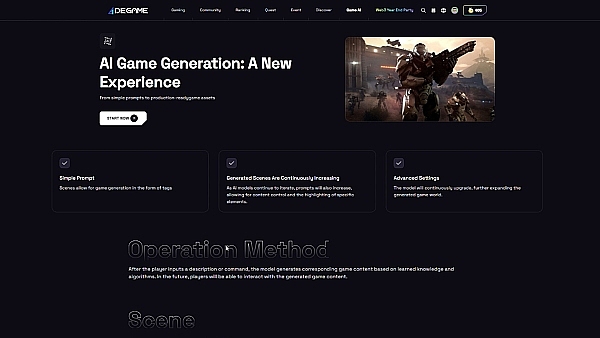Author: DeMan
In the world of Web3 games, we have witnessed a challenging era. From 2018 to 2023, a total of 2,817 Web3 games were released, but sadly, 2,127 of them (75.5%) failed to succeed, which highlights the difficulties of the industry.
Although Web3 games have never really set off a craze since 2018, Web3 games are often highly expected every time cryptocurrencies turn a new page. Combined with the current bull market expectations, we are likely to see many games reach crazy valuations.

Looking only at 2024 and 2025, with the concentrated outbreak of many AI models such as DALL-E, Stable Diffusion, Midjourney, and ChatGPT, we believe that "AI penetration into Web3" will become its key driving force. Based on AI technology breakthroughs, in July, DeGame officially announced the launch of the "AI generated game" function, hoping to bring a new attempt to the strong recovery of the Web3 game industry through a series of interoperable, composable, programmable and tools, as well as modular game/video/voice generation models.
With nearly 3 billion Web2 game players and nearly 600 million Web3 users worldwide, Web3 games have a strong narrative foundation. However, at present, funds and projects are more concentrated at the infrastructure level, lacking new growth points in large-scale user adoption and conversion narratives.
The key to promoting the development of the game industry is actually technological change. The application of AI technology in game development is becoming increasingly mature. Using AI generation models to solve the typical problems faced by Web3 games, so as to achieve breakthroughs and growth in the short term, may be the best solution.
01 Ice-breaking Narrative "Ice Age"
Playability is the main drawback that previously restricted Web3 games from acquiring large-scale players. The monotonous gameplay and rough graphics often make players flash back to more than a decade ago when participating in Web3 games. But for ordinary players, there has always been only one hard standard for evaluating the pros and cons of a game, that is, whether it is fun; Web3 games that overly focus on "Fi" can only attract gold-making people, but cannot complete the large-scale conversion of Web2 users.
But from a realistic perspective, as an extremely money-burning and time-consuming industry, the outbreak of the game sector requires the joint promotion of multiple factors such as capital, time and technology. By 2024, AI seems to be able to bring these elements together. The improvement of modular AI generation tools has provided stronger support for Web3 games to improve towards 3A-level production and high quality.
In traditional games, NPCs (non-player characters) have very limited artificial intelligence and can often only operate under fixed circumstances. With the help of AI technology, NPCs can simulate human behavior more realistically and have more intelligent operation methods. For example, the real-time dialogue decryption of AI NPCs in "Save Me! Labor Law Protector" increases the interactivity and immersion of the game.
In addition, AI can also be used to generate environments, character images, and numerical balance, further enriching the diversity and playability of games, making interactions in games more convenient and natural. Traditional game interaction methods are often based on keyboards and mice, which are difficult to meet the needs of players. With the help of AI technology, more intuitive and vivid interaction methods can be achieved, such as voice, gestures, expressions, and so on.
Overall, the most successful application of AI in the gaming field is undoubtedly to enhance the gaming experience and personalize the gaming content. The AI generation model can optimize the game development process in a short period of time, integrate the multiple highlights of traditional Web2 games at a lower development cost, and improve the smoothness of incremental users participating in Web3 games, which is an important part of the large-scale migration of Web2 users to Web3 games.
02 Unleash unlimited creativity
Decentralized blockchain is an important force to balance AI (and machine learning). First, it can be combined with other technologies, such as ZK, to optimize the trust framework of machine learning. Second, it can effectively utilize long-tail resources to reduce the cost and threshold of using AI. On the other hand, because many Web3 applications sacrifice user experience for security and decentralization, AI can help optimize and improve user experience. This is the part where AI can empower Web3.
Specific to the application scenarios, although AI+DeFi and AI+DID/social both have use cases, generative AI is naturally applicable to the gameplay familiar to Web2 users, such as text, sandbox, cultivation, open world, UGC, etc., by rewriting the game logic through AI, making the game more uncertain and random, which will make Web3 games and AI collide with different sparks.
For example, an important innovation of Web3 games is that it requires users and platforms to participate in the creation process together, rather than a planned finite game. In the game, there will be a concept of Lore. In traditional games, this is planned by the game designer and is completely predictable. Through the AI model, various inputs can be brought together and unpredictable outputs can be generated. Such a game has infinite possibilities.
Imagine that one day in the future, we will be able to access a magical virtual world through AR/VR devices. We can instantly create 2D and 3D objects that we can imagine or cannot imagine in our minds through prompts, just like reciting a magical spell, and then we really own them (data is hosted on the public chain). We can also interact with the intelligent AI NPCs in the virtual world and influence the development of the story of the entire game world, and all of this will be supported by a completely transparent open source infrastructure.
Under this vision, AI drives the Web3 game field and will unleash unlimited creativity.
03 Rapid evolution and continuous integration
In fact, the prototype of AI game development history may be traced back to an earlier time.
The application of AI in game development can be traced back to classic games such as "StarCraft" and "Diablo". At that time, developers needed to use AI systems to create interactive virtual worlds and characters. These systems have become standard for the development of such interactive platforms.
Early research related to game development AI emphasized controlling non-player characters (NPCs), and with the development of natural language processing (NLP) technology, there has been some pioneering work using deep learning technology to generate levels.
One of the representative works is MarioGPT, which successfully generated some levels in "Super Mario Bros." through a fine-tuned GPT-2 model.
With the rapid iteration of the model, AI's capabilities are becoming more and more powerful. For practitioners in the Web3 game field, how to use AI to better create high-quality games and how to apply AI-generated models to the research and development process are the core of seizing incremental users.

We hope to see emergent, procedurally generated worlds, each with its own rich history, inhabitants, and mysteries. There will be interactive novels, where stories evolve through player choices and are told through generated images, videos, and audio, giving Web3 games more possibilities.
Written at the end
If a practitioner in the Web3 game field wants to complete a game work, it must at least cover interactivity, playability, and content with a game plot core, consider the plot connection between the characters in the game, and also carefully design game levels and goals for the players. With the help of cutting-edge AI generative models, creativity and imagination can be transformed into complex game mechanisms and storylines, and AI NPCs with vivid personality traits can be designed to lead players' actions, trigger the direction of the game story, and improve the efficiency of game development and operation, reduce the development and operation costs of the game, and thus generate new profit growth points.
AI technology has many directions of application in the development and operation of games, including game plot planning, map generation, level setting, task generation, dialogue generation, story narration, model generation, and the generation of rules such as growth systems and economic systems in games.
It's just the beginning now, and we believe that the exploration in the field of AI and Web3 games will open a door to a new game world. With the advancement of technology and the deepening of its application, players can expect to encounter more unique game experiences that will go beyond the boundaries of traditional games and bring a more immersive and interactive game world. This is an exciting era for players who love games and technological innovation.
 Joy
Joy








